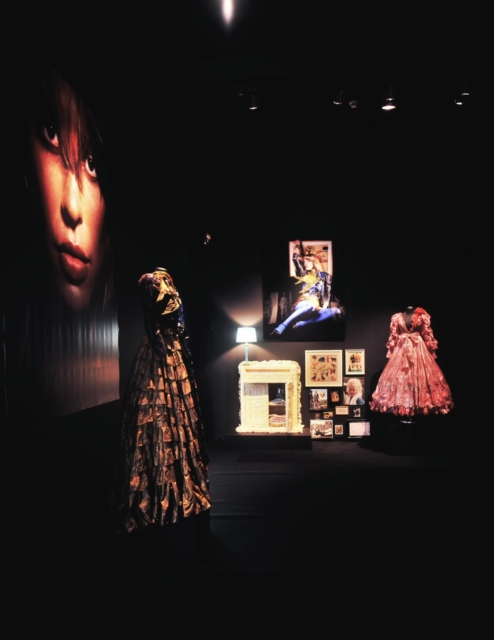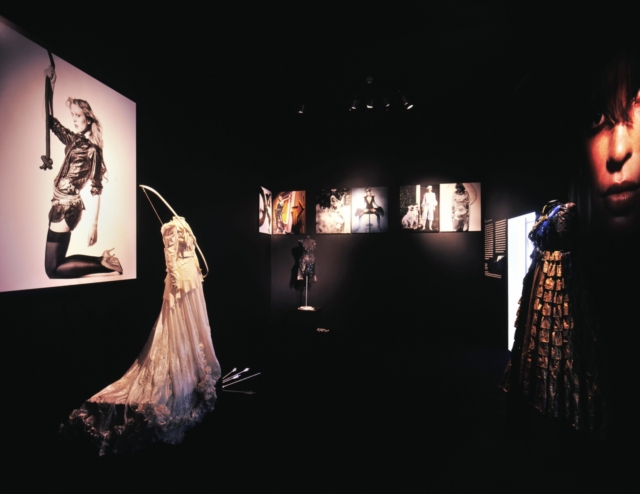AICO DINKLA
PEOPLEText: Ania Markham
It wasn’t long before Aico’s designs started getting noticed in the world of haute couture and, ‘after visiting Hong Kong, I was advised to go to London (Covent Garden and Soho) and show my designs to certain exclusive boutiques. These places were seriously involved in the fashion scene, representing and promoting really high-class designers and I really wasn’t sure what they would make of my work. However I got such a positive reaction that I started supplying them my hand-made designs almost immediately.’
It was a turning point and from then on his profile grew rapidly as he was courted by the London fashion intelligentsia. ‘It also made it easier for me in the Netherlands. From the beginning the Dutch were a bit funny about the material – it seemed a bit too sexual for their taste – all that plastic, rubber feel. Probably too S&M although that was not my intention in the slightest. But once London embraced it, so did the Dutch and I was approached by the most exclusive fashion shop Reflections 66-68 (PC Hooftstraat) which had developed a reputation for selling edgy Japanese and Italian designers. My work fitted in really well there because it’s a mix between both styles – sexy and sophisticated like the Italian/French look but fresh and challenging like much of the Japanese clothes.’
In 1999, Aico embarked on a solo self-sponsored project called ‘The Aico Project’ with the help of the widely respected Ted Polheamus. ‘The idea behind it was to take one collection of my work and have it interpreted in numerous ways. So I approached 12 renowned Dutch photographers to work with me on this one-off book. Each photographer set up a team including stylists and make-up artists and got to work. The only other main defining point was that there would only be two models – my sister Iefke and my mother Kinge. It was the first time I introduced the special, symbiotic relationship I have always had with my sister into my work. We’ve always connected in an almost obsessive way and we replicated that symbiotic connection within the fashion industry – she became a professional model and I the fashion designer. She became my muse, that’s for sure.’

Aico Dinkla “What you see I is wearing you can’t get” Exhibition view, Centraal Museum, 2003
The book established Aico in an even better position and left no one in doubt that this was a fast-emerging, unique talent. Their careers’ developed at speed and the connection between Aico and his sister became stronger and stronger. ‘It was a difficult time for both of us as the fashion industry can suck the life out of you. It reached a point last year where I was advised to do London Fashion Week and then suddenly, advised to change direction and go for Paris instead. But by then I almost knew what I had to do and that was to do neither. I’d made up my mind that I didn’t want to do any more straight fashion shows again. Both for my sake and Iefke’s. It felt that my work was beginning to be compartmentalized and shaped – made to fit into the commercial requirements of the fashion industry. And that felt wrong. Instead I wanted to focus and develop the influences that had shaped my work such as my background and relationship with Iefke even if that meant moving further into the art world.’
After the Utrecht Museum approached Aico to take part in this years Neo exhibition (offering a solo room for his contribution) he started working on this new direction for his work, ‘It was important for me to visualize the dreams, past and stories shared by Iefke and myself. I wanted to create a room that felt like our own world and own dreams but also was recognizable as an illusion, because that’s what I feel fashion essentially is. We both had dreams about reaching the top in our professions without knowing all the sorrow, depressions and superficial treatment of people so commonplace in the fashion industry. The reality was very different and a wake-up call. It was not our cup of tea and perhaps that comes down to the Dutch style or our upbringing. My father always told us everything is possible if you believe in yourself but forgot to say that you should always stay true to yourself in the process. The birth of the concept of the room came as an act of love for Iefke. I wanted to include more personal artifacts and elements from our lives’ into the room but there was a specific brief from the museum and expanding it too far beyond the actual fashion would not have fitted into the Neo exhibition. I’m currently in talks with a couple of museums (including the prestigious Groningen Museum) to be able to realize my original concept fully – a stand-alone exhibition to further explore the inter-dependent relationship that I share with Iefke and hopefully, finally lay it to rest.’

Aico Dinkla “What you see I is wearing you can’t get” Exhibition view, Centraal Museum, 2003
Saying that, however, this collection would not be here if it wasn’t for my relationship with Iefke but I don’t always want to work with this concept for my collections. Nor do I want to be known as the silicon kid. These are just stages in my development. I fully intend to explore new materials, sources, methods and platforms for my creative output. I see myself as a multi-disciplined artist and that means creating in whatever form I choose, be it sculpture, photography or even written word. On the one hand, I don’t want to let go of the fashion completely but I also want to combine it with poems, statements or even personal images. Perhaps you could describe it as being an individual visionary? Or perhaps I am just lucky I noticed I am an artist and not a fashion designer?
For the immediate future, Aico works to commission, continuing to create unique designs for projects ranging from feature films through to ballet performances. He’s also in discussion for another solo museum project although his real ambition is to have exhibitions in locations around the world that have been sources of inspiration in his work. ‘Japan is an obvious one because I have drawn so many references from it over the years’.
Aico Dinkla “What you see I is wearing you can’t get”
Date: August 30 – November 30th, 2003
Place: Centraal Museum
Address: 10 Nicolaaskerkhof, Utrecht, The Netherlands
Tel: +31 (0)30 236 2353
https://www.centraalmuseum.nl
Text: Ania Markham
Photos: Courtesy Centraal Museum, Utrecht © Aico Dinkla









